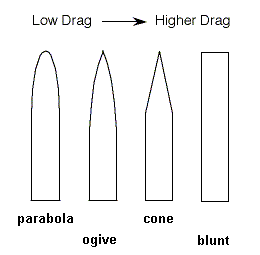There are more to it then just curvy side, I did some research and here what I came up with:
Most supersonic aircraft, rockets, and missiles use a nose shape very similar to a cone but a little more rounded to provide more internal volume. This shape is called an ogive (pronounced "oh-zheeve" or "oh-zhive"). The faster the vehicle is designed to go, the more pointed the ideal aerodynamic nose shape becomes.
The ideal nose shape for a projectile that minimizes its drag and maximizes its altitude depends on how fast the projectile is designed to travel
Tangent ogive
Next to a simple cone, the tangent ogive shape is the most familiar in hobby rocketry. The profile of this shape is formed by a segment of a circle such that the rocket body is tangent to the curve of the nose cone at its base; and the base is on the radius of the circle. The popularity of this shape is largely due to the ease of constructing its profile.
The radius of the circle that forms the ogive is called the Ogive Radius ρ and it is related to the length and base radius of the nose cone as expressed by the formula : ρ = (R^2 + L^2) / 2R The radius y at any point x, as x varies from 0 to L is: y = sqrt(ρ^2 - (x - L)^2)+R - ρ The nose cone length, L, must be equal to, or less than the Ogive Radius ρ. If they are equal, then the shape is a hemisphere.
Secant ogive
The profile of this shape is also formed by a segment of a circle, but the base of the shape is not on the radius of the circle defined by the ogive radius. The rocket body will not be tangent to the curve of the nose at its base. The Ogive Radius ρ is not determined by R and L (as it is for a tangent ogive), but rather is one of the factors to be chosen to define the nose shape. If the chosen Ogive Radius of a Secant Ogive is greater than the Ogive Radius of a Tangent Ogive with the same R and L, then the resulting Secant Ogive appears as a Tangent Ogive with a portion of the base truncated.
ρ > {R^2 + L^2 / 2R} and alpha = arctan ({R / L}) - arccos ({sqrt{L^2+R^2} / 2ρ})
If the chosen ρ is less than the tangent ogive ρ, then the result will be a Secant Ogive that bulges out to a maximum diameter that is greater than the base diameter. The classic example of this shape is the nose cone of the Honest John. Also, the chosen ogive radius must be greater than twice the length of the nose cone.
Told you just get bullet comparator...




